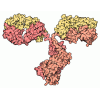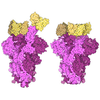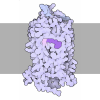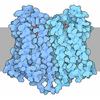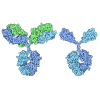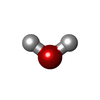[English] 日本語
 Yorodumi
Yorodumi- PDB-9jqz: Structural Insights into Selective Antagonism Grapiprant and EP4 ... -
+ Open data
Open data
- Basic information
Basic information
| Entry | Database: PDB / ID: 9jqz | ||||||||||||||||||||||||
|---|---|---|---|---|---|---|---|---|---|---|---|---|---|---|---|---|---|---|---|---|---|---|---|---|---|
| Title | Structural Insights into Selective Antagonism Grapiprant and EP4 Prostaglandin Receptor | ||||||||||||||||||||||||
 Components Components |
| ||||||||||||||||||||||||
 Keywords Keywords | MEMBRANE PROTEIN/IMMUNE SYSTEM / GPCR / MEMBRANE PROTEIN-IMMUNE SYSTEM complex | ||||||||||||||||||||||||
| Function / homology |  Function and homology information Function and homology informationnegative regulation of eosinophil extravasation / prostaglandin E receptor activity / negative regulation of integrin activation / Prostanoid ligand receptors / T-helper cell differentiation / regulation of stress fiber assembly / negative regulation of cytokine production / response to mechanical stimulus / response to prostaglandin E / JNK cascade ...negative regulation of eosinophil extravasation / prostaglandin E receptor activity / negative regulation of integrin activation / Prostanoid ligand receptors / T-helper cell differentiation / regulation of stress fiber assembly / negative regulation of cytokine production / response to mechanical stimulus / response to prostaglandin E / JNK cascade / ERK1 and ERK2 cascade / positive regulation of cytokine production / cellular response to mechanical stimulus / adenylate cyclase-inhibiting G protein-coupled receptor signaling pathway / bone development / adenylate cyclase-modulating G protein-coupled receptor signaling pathway / negative regulation of inflammatory response / adenylate cyclase-activating G protein-coupled receptor signaling pathway / positive regulation of inflammatory response / cellular response to prostaglandin E stimulus / positive regulation of cytosolic calcium ion concentration / G alpha (s) signalling events / immune response / inflammatory response / membrane / plasma membrane Similarity search - Function | ||||||||||||||||||||||||
| Biological species |  synthetic construct (others)  Homo sapiens (human) Homo sapiens (human) | ||||||||||||||||||||||||
| Method | ELECTRON MICROSCOPY / single particle reconstruction / cryo EM / Resolution: 2.65 Å | ||||||||||||||||||||||||
 Authors Authors | Wu, Y.L. / Zhang, H. / Xu, J.Y. / Wu, C.R. / Xu, E.H. | ||||||||||||||||||||||||
| Funding support |  China, 1items China, 1items
| ||||||||||||||||||||||||
 Citation Citation |  Journal: To Be Published Journal: To Be PublishedTitle: Structural Insights into Selective and Dual Antagonism of EP2 and EP4 Prostaglandin Receptor Authors: Wu, Y.L. / Zhang, H. / Xu, J.Y. / Wu, K. / Hu, W. / Wu, C.R. / Xu, E.H. | ||||||||||||||||||||||||
| History |
|
- Structure visualization
Structure visualization
| Structure viewer | Molecule:  Molmil Molmil Jmol/JSmol Jmol/JSmol |
|---|
- Downloads & links
Downloads & links
- Download
Download
| PDBx/mmCIF format |  9jqz.cif.gz 9jqz.cif.gz | 183.1 KB | Display |  PDBx/mmCIF format PDBx/mmCIF format |
|---|---|---|---|---|
| PDB format |  pdb9jqz.ent.gz pdb9jqz.ent.gz | Display |  PDB format PDB format | |
| PDBx/mmJSON format |  9jqz.json.gz 9jqz.json.gz | Tree view |  PDBx/mmJSON format PDBx/mmJSON format | |
| Others |  Other downloads Other downloads |
-Validation report
| Summary document |  9jqz_validation.pdf.gz 9jqz_validation.pdf.gz | 1.3 MB | Display |  wwPDB validaton report wwPDB validaton report |
|---|---|---|---|---|
| Full document |  9jqz_full_validation.pdf.gz 9jqz_full_validation.pdf.gz | 1.3 MB | Display | |
| Data in XML |  9jqz_validation.xml.gz 9jqz_validation.xml.gz | 37.9 KB | Display | |
| Data in CIF |  9jqz_validation.cif.gz 9jqz_validation.cif.gz | 55 KB | Display | |
| Arichive directory |  https://data.pdbj.org/pub/pdb/validation_reports/jq/9jqz https://data.pdbj.org/pub/pdb/validation_reports/jq/9jqz ftp://data.pdbj.org/pub/pdb/validation_reports/jq/9jqz ftp://data.pdbj.org/pub/pdb/validation_reports/jq/9jqz | HTTPS FTP |
-Related structure data
| Related structure data |  61744MC  9jqyC  9jroC  9jrtC M: map data used to model this data C: citing same article ( |
|---|---|
| Similar structure data | Similarity search - Function & homology  F&H Search F&H Search |
- Links
Links
- Assembly
Assembly
| Deposited unit | 
|
|---|---|
| 1 |
|
- Components
Components
| #1: Antibody | Mass: 27574.092 Da / Num. of mol.: 1 Source method: isolated from a genetically manipulated source Source: (gene. exp.)   |
|---|---|
| #2: Protein | Mass: 61463.859 Da / Num. of mol.: 1 / Mutation: T228A,N232Q,A287L,G331R,N402Q Source method: isolated from a genetically manipulated source Source: (gene. exp.) synthetic construct (others), (gene. exp.)  Homo sapiens (human) Homo sapiens (human)Gene: PTGER4, PTGER2 / Production host:  |
| #3: Antibody | Mass: 28944.303 Da / Num. of mol.: 1 Source method: isolated from a genetically manipulated source Source: (gene. exp.)   |
| #4: Chemical | ChemComp-A1ECR / Mass: 491.605 Da / Num. of mol.: 1 / Source method: obtained synthetically / Formula: C26H29N5O3S / Feature type: SUBJECT OF INVESTIGATION |
| #5: Water | ChemComp-HOH / |
| Has ligand of interest | Y |
| Has protein modification | Y |
-Experimental details
-Experiment
| Experiment | Method: ELECTRON MICROSCOPY |
|---|---|
| EM experiment | Aggregation state: PARTICLE / 3D reconstruction method: single particle reconstruction |
- Sample preparation
Sample preparation
| Component | Name: human prostaglandin E receptor EP4 / Type: COMPLEX / Entity ID: #1, #3 / Source: RECOMBINANT | ||||||||||||
|---|---|---|---|---|---|---|---|---|---|---|---|---|---|
| Source (natural) |
| ||||||||||||
| Source (recombinant) | Organism:  | ||||||||||||
| Buffer solution | pH: 7.3 | ||||||||||||
| Specimen | Embedding applied: NO / Shadowing applied: NO / Staining applied: NO / Vitrification applied: YES | ||||||||||||
| Vitrification | Cryogen name: ETHANE |
- Electron microscopy imaging
Electron microscopy imaging
| Experimental equipment |  Model: Titan Krios / Image courtesy: FEI Company |
|---|---|
| Microscopy | Model: TFS KRIOS |
| Electron gun | Electron source:  FIELD EMISSION GUN / Accelerating voltage: 300 kV / Illumination mode: SPOT SCAN FIELD EMISSION GUN / Accelerating voltage: 300 kV / Illumination mode: SPOT SCAN |
| Electron lens | Mode: DIFFRACTION / Nominal defocus max: 3000 nm / Nominal defocus min: 1000 nm |
| Image recording | Electron dose: 50 e/Å2 / Film or detector model: GATAN K3 BIOCONTINUUM (6k x 4k) |
- Processing
Processing
| EM software | Name: PHENIX / Category: model refinement | ||||||||||||||||||||||||
|---|---|---|---|---|---|---|---|---|---|---|---|---|---|---|---|---|---|---|---|---|---|---|---|---|---|
| CTF correction | Type: PHASE FLIPPING AND AMPLITUDE CORRECTION | ||||||||||||||||||||||||
| 3D reconstruction | Resolution: 2.65 Å / Resolution method: FSC 0.143 CUT-OFF / Num. of particles: 287641 / Symmetry type: POINT | ||||||||||||||||||||||||
| Refine LS restraints |
|
 Movie
Movie Controller
Controller





 PDBj
PDBj